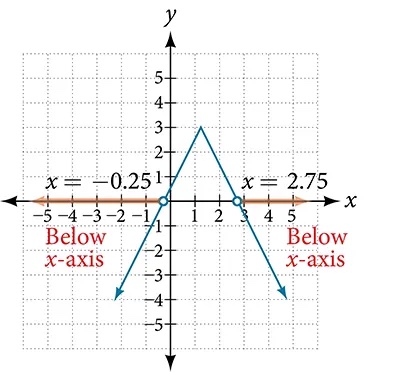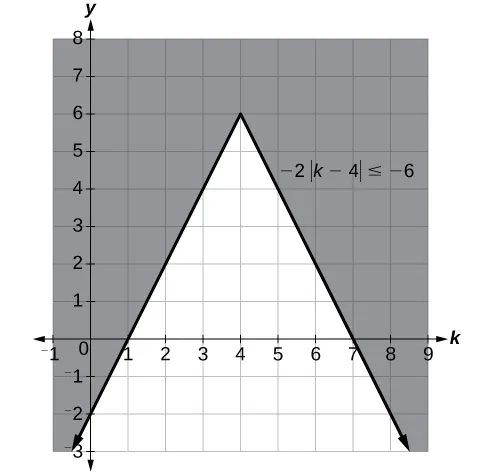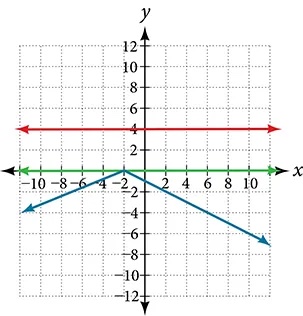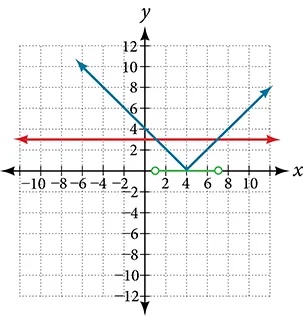Chapter 2 Equations and Inequalities
2.6 Linear Inequalities and Absolute Value Inequalities
Learning Objectives
In this section, you will:
- Write solutions using interval notation.
- Solve inequalities in one variable algebraically.
- Solve absolute value inequalities.

It is not easy to make the honor roll at most top universities. Suppose students were required to carry a course load of at least 12 credit hours and maintain a grade point average of 3.5 or above. How could these honor roll requirements be expressed mathematically? In this section, we will explore various ways to express different sets of numbers, inequalities, and absolute value inequalities.
Write Solutions Using Interval Notation
Indicating the solution to an inequality such as[latex]\,x\ge 4\,[/latex]can be achieved in several ways.
We can use a number line as shown in Figure 2. The blue ray begins at[latex]\,x=4\,[/latex]and, as indicated by the arrowhead, continues to infinity, which illustrates that the solution set includes all real numbers greater than or equal to 4.

We can use set-builder notation:[latex]\,\left\{x|x\ge 4\right\},[/latex] which translates to “all real numbers x such that x is greater than or equal to 4.” Notice that braces are used to indicate a set.
The third method is interval notation, in which solution sets are indicated with parentheses or brackets. The solutions to[latex]\,x\ge 4\,[/latex]are represented as[latex]\,\left[4,\infty \right).\,[/latex]This is perhaps the most useful method, as it applies to concepts studied later in this course and to other higher-level math courses.
The main concept to remember is that parentheses represent solutions greater or less than the number, and brackets represent solutions that are greater than or equal to or less than or equal to the number. Use parentheses to represent infinity or negative infinity, since positive and negative infinity are not numbers in the usual sense of the word and, therefore, cannot be “equaled.” A few examples of an interval, or a set of numbers in which a solution falls, are[latex]\,\left[-2,6\right)[/latex], or all numbers between[latex]\,-2\,[/latex]and[latex]\,6[/latex], including[latex]\,-2[/latex] , but not including[latex]\,6[/latex]; [latex]\left(-1,0\right)[/latex], all real numbers between, but not including[latex]\,-1\,[/latex], and[latex]\,0[/latex]; and[latex]\,\left(-\infty ,1\right],[/latex] all real numbers less than and including[latex]\,1.\,[/latex] Table 1 below outlines the possibilities.
| Set Indicated | Set-Builder Notation | Interval Notation |
|---|---|---|
| All real numbers between a and b, but not including a or b | [latex]\left\{x|a\lt x\lt b\right\}[/latex] | [latex]\left(a,b\right)[/latex] |
| All real numbers greater than a, but not including a | [latex]\left\{x|x\gt a\right\}[/latex] | [latex]\left(a,\infty \right)[/latex] |
| All real numbers less than b, but not including b | [latex]\left\{x|x\lt b\right\}[/latex] | [latex]\left(-\infty ,b\right)[/latex] |
| All real numbers greater than a, including a | [latex]\left\{x|x\ge a\right\}[/latex] | [latex]\left[a,\infty \right)[/latex] |
| All real numbers less than b, including b | [latex]\left\{x|x\le b\right\}[/latex] | [latex]\left(-\infty ,b\right][/latex] |
| All real numbers between a and b, including a | [latex]\left\{x|a\le x\lt;b\right\}[/latex]
[latex]\left\{x|a\le x\lt b\right\}[/latex] |
[latex]\left[a,b\right)[/latex] |
| All real numbers between a and b, including b | [latex]\left\{x|a\lt;x\le b\right\}[/latex] | [latex]\left(a,b\right][/latex] |
| All real numbers between a and b, including a and b | [latex]\left\{x|a\le x\le b\right\}[/latex] | [latex]\left[a,b\right][/latex] |
| All real numbers less than a or greater than b | [latex]\left\{x|x\lt a\,\text{or}\,x\gt b\right\}[/latex] | [latex]\left(-\infty ,a\right)\cup \left(b,\infty \right)[/latex] |
| All real numbers | [latex]\left\{x|x\text{ is all real numbers}\right\}[/latex] | [latex]\left(-\infty ,\infty \right)[/latex] |
Using Interval Notation to Express All Real Numbers Greater Than or Equal to a
Use interval notation to indicate all real numbers greater than or equal to[latex]\,-2.[/latex]
Show Solution
Use a bracket on the left of[latex]\,-2\,[/latex]and parentheses after infinity:[latex]\,\left[-2,\infty \right).[/latex]The bracket indicates that[latex]\,-2\,[/latex]is included in the set with all real numbers greater than[latex]\,-2\,[/latex]to infinity.
Try It
Use interval notation to indicate all real numbers between and including[latex]\,-3\,[/latex]and[latex]\,5.[/latex]
Show Solution
[latex]\left[-3,5\right][/latex]
Using Interval Notation to Express All Real Numbers Less Than or Equal to a or Greater Than or Equal to b
Write the interval expressing all real numbers less than or equal to[latex]\,-1\,[/latex]or greater than or equal to[latex]\,1.[/latex]
Show Solution
We have to write two intervals for this example. The first interval must indicate all real numbers less than or equal to 1. So, this interval begins at[latex]\,-\infty \,[/latex]and ends at[latex]\,-1,[/latex]which is written as[latex]\,\left(-\infty ,-1\right].[/latex]
The second interval must show all real numbers greater than or equal to[latex]\,1,[/latex]which is written as[latex]\,\left[1,\infty \right).\,[/latex]However, we want to combine these two sets. We accomplish this by inserting the union symbol,[latex]\cup ,[/latex]between the two intervals.
Try It
Express all real numbers less than[latex]\,-2\,[/latex]or greater than or equal to [latex]3[/latex] in interval notation.
Show Solution
[latex]\left(-\infty ,-2\right)\cup \left[3,\infty \right)[/latex]
Solving Inequalities in One Variable Algebraically
Using the Properties of Inequalities
When we work with inequalities, we can usually treat them similarly to but not exactly as we treat equalities. We can use the addition property and the multiplication property to help us solve them. The one exception is when we multiply or divide by a negative number; doing so reverses the inequality symbol.
Properties of Inequalities
These properties also apply to[latex]\,a\le b,[/latex][latex]a \gt b,[/latex] and[latex]\,a\ge b.[/latex]
Demonstrating the Addition Property
Illustrate the addition property for inequalities by solving each of the following:
a. [latex]x-15\lt 4[/latex]
b. [latex]6\ge x-1[/latex]
c. [latex]x+7\gt 9[/latex]
Show Solution
The addition property for inequalities states that if an inequality exists, adding or subtracting the same number on both sides does not change the inequality.
a. [latex]x-15\lt 4[/latex]
| [latex]x-15+15\lt 4+15[/latex] | Add 15 to both sides. |
| [latex]x \lt 19[/latex] |
b. [latex]6\ge x-1[/latex]
| [latex]6+1\ge x-1+1[/latex] | Add 1 to both sides. |
| [latex]7\ge x[/latex] |
c. [latex]x+7\gt 9[/latex]
| [latex]x+7-7>9-7[/latex] | Subtract 7 from both sides. |
| [latex]x\gt 2[/latex] |
Try It
Solve:[latex]\,3x-2 \lt 1.[/latex]
Show Solution
[latex]x \lt 1[/latex]
Demonstrating the Multiplication Property
Illustrate the multiplication property for inequalities by solving each of the following:
- [latex]3x\lt 6[/latex]
- [latex]-2x-1\ge 5[/latex]
- [latex]5-x>10[/latex]
Show Solution
a. [latex]3x\lt 6[/latex]
| [latex]{3}\left(3x\right)\lt \left(6\right)\frac{1}{3}[/latex] | Multiply by [latex]\frac{1}{3}[/latex]. |
| [latex]x\lt 2[/latex] |
b. [latex]-2x-1\ge 5[/latex]
| [latex]-2x\ge 6[/latex] | |
| [latex]\left(-\frac{1}{2}\right)\left(-2x\right)\ge \left(6\right)\left(-\frac{1}{2}\right)[/latex] | Multiply by [latex]-\frac{1}{2}[/latex]. |
| [latex]x\le -3[/latex] | Reverse the inequality. |
c. [latex]5-x>10[/latex]
| [latex]-x>5[/latex] | |
| [latex]\left(-1\right)\left(-x\right)>\left(5\right)\left(-1\right)[/latex] | Multiply by [latex]-1[/latex]. |
| [latex]x\lt -5[/latex] | Reverse the inequality. |
Try It
Solve:[latex]\,4x+7\ge 2x-3.[/latex]
Show Solution
[latex]x\ge -5[/latex]
As the examples have shown, we can perform the same operations on both sides of an inequality, just as we do with equations; we combine like terms and perform operations. To solve, we isolate the variable.
Solving an Inequality Algebraically
Solve the inequality: [latex]13 - 7x \geq 10x - 4[/latex]
Show Solution
Solving this inequality is similar to solving an equation up until the last step.
| [latex]13 - 7x \geq 10x - 4[/latex] | |
| [latex]13 - 17x \geq - 4[/latex] | Move variable terms to one side of the inequality. |
| [latex]- 17x \geq - 17[/latex] | Isolate the variable term. |
| [latex]x \leq 1[/latex] | Dividing both sides by -17 reverses the inequality. |
The solution set is given by the interval[latex]\,\left(-\infty ,1\right],[/latex] or all real numbers less than and including [latex]1[/latex].
Try It
Solve the inequality and write the answer using interval notation:[latex]\,-x+4\lt\frac{1}{2}x+1.[/latex]
Show Solution
[latex]\left(2,\infty \right)[/latex]
Solving an Inequality with Fractions
Solve the following inequality and write the answer in interval notation:
[latex]- \frac{3}{4}x \geq -\frac{5}{8}+ \frac{2}{3}x[/latex]
Show Solution
We begin solving in the same way we do when solving an equation.
| [latex]- \dfrac{3}{4}x \geq -\dfrac{5}{8}+ \dfrac{2}{3}x[/latex] | |
| [latex]- \dfrac{3}{4}x -\dfrac{2}{3}x \geq -\dfrac{5}{8}[/latex] | Put variable terms on one side. |
| [latex]- \dfrac{9}{12} x - \dfrac{8}{10}x \geq - \dfrac{5}{8}[/latex] | Write fractions with the common denominator. |
| [latex]- \dfrac{17}{12} x \geq - \dfrac{5}{8}[/latex] | |
| [latex]x \leq - \dfrac{5}{8} \left(- \dfrac{12}{17}\right)[/latex] | Multiplying by a negative number reverses the inequality. |
| [latex]x \leq - \dfrac{15}{34}[/latex] |
Try It
Solve the inequality and write the answer in interval notation:[latex]\,-\frac{5}{6}x\le \frac{3}{4}+\frac{8}{3}x.[/latex]
Show Solution
[latex]\left[-\frac{3}{14},\infty \right)[/latex]
Understanding Compound Inequalities
A compound inequality includes two inequalities in one statement. A statement such as [latex]\,4\lt x\le 6\,[/latex] means [latex]\,4 \lt x\,[/latex] and [latex]\,x\le 6.\,[/latex]There are two ways to solve compound inequalities: separating them into two separate inequalities or leaving the compound inequality intact and performing operations on all three parts at the same time. We will illustrate both methods.
Solving a Compound Inequality
Solve the compound inequality: [latex]3 \leq 2x + 2 \lt 6[/latex]
Show Solution
The first method is to write two separate inequalities: [latex]3 \leq 2x + 2[/latex] and [latex]2x + 2 \lt 6[/latex] . We solve them independently.
| [latex]3 \leq 2x + 2[/latex] | [latex]and[/latex] | [latex]2x + 2 \lt 6[/latex] |
| [latex]1 \leq 2x [/latex] | [latex]2x \lt 4[/latex] | |
| [latex]\dfrac{1}{2} \leq x[/latex] | [latex]x \lt 2[/latex] |
Then, we can rewrite the solution as a compound inequality, the same way the problem began.
[latex]\dfrac{1}{2} \leq x \lt 2[/latex]
In interval notation, the solution is written as [latex][ \dfrac{1}{2}, 2)[/latex].
The second method is to leave the compound inequality intact and perform solving procedures on the three parts at the same time.
| [latex]3 \leq 2x + 2 \lt 6[/latex] | |
| [latex]1 \leq 2x \lt 4[/latex] | Isolate the variable term, and subtract 2 from all three parts. |
| [latex]\dfrac{1}{2} \leq x \lt 2[/latex] | Divide through all three parts by 2. |
We get the same solution:[latex][ \dfrac{1}{2}, 2)[/latex].
Try It
Solve the compound inequality:[latex]\,4\lt 2x-8\le 10.[/latex]
Show Solution
[latex]6\lt x\le 9\text{}\text{}\,\,\text{or}\,\,\left(6,9\right][/latex]
Solving a Compound Inequality with the Variable in All Three Parts
Solve the compound inequality with variables in all three parts:[latex]\,3+x>7x-2>5x-10.[/latex]
Show Solution
Let's try the first method. Write two inequalities:
The solution set is[latex]\,-4\lt x\lt\frac{5}{6}\,[/latex]or in interval notation[latex]\,\left(-4,\frac{5}{6}\right).\,[/latex]Notice that when we write the solution in interval notation, the smaller number comes first. We read intervals from left to right, as they appear on a number line. See Figure 3.

Try It
Solve the compound inequality:[latex]\,3y\lt 4-5y\lt 5+3y.[/latex]
Show Solution
[latex]\left(-\frac{1}{8},\frac{1}{2}\right)[/latex]
Solving Absolute Value Inequalities
As we know, the absolute value of a quantity is a positive number or zero. From the origin, a point located at[latex]\,\left(-x,0\right)\,[/latex]has an absolute value of[latex]\,x,[/latex] as it is x units away. Consider absolute value the distance from one point to another point. Regardless of direction, positive or negative, the distance between the two points is represented as a positive number or zero.
An absolute value inequality is an equation of the form
where A, and sometimes B, represents an algebraic expression dependent on a variable x. Solving the inequality means finding the set of all [latex]\,x[/latex]-values that satisfy the problem. Usually this set will be an interval or the union of two intervals and will include a range of values.
There are two basic approaches to solving absolute value inequalities: graphical and algebraic. The advantage of the graphical approach is we can read the solution by interpreting the graphs of two equations. The advantage of the algebraic approach is that solutions are exact, as precise solutions are sometimes difficult to read from a graph.
Suppose we want to know all possible returns on an investment if we could earn some amount of money within $200 of $600. We can solve algebraically for the set of x-values such that the distance between[latex]\,x\,[/latex]and [latex]600[/latex]is less than [latex]200[/latex]. We represent the distance between[latex]\,x\,[/latex]and [latex]600[/latex]as[latex]\,|x-600|,[/latex] and therefore,[latex]\,|x-600|\le 200\,[/latex]or
This means our returns would be between $400 and $800.
To solve absolute value inequalities, just as with absolute value equations, we write two inequalities and then solve them independently.
Absolute Value Inequalities
For an algebraic expression X, and[latex]\,k>0,[/latex] an absolute value inequality is an inequality of the form
These statements also apply to[latex]\,|X|\le k\,[/latex]and[latex]\,|X|\ge k.[/latex]
Determining a Number within a Prescribed Distance
Describe all values[latex]\,x\,[/latex]within a distance of [latex]4[/latex]from the number [latex]5[/latex].
Show Solution
We want the distance between[latex]\,x\,[/latex]and [latex]5[/latex] to be less than or equal to [latex]4[/latex]. We can draw a number line, such as in Figure 4, to represent the condition to be satisfied.

The distance from[latex]\,x\,[/latex]to [latex]5[/latex] can be represented using an absolute value symbol,[latex]\,|x-5|.\,[/latex]Write the values of[latex]\,x\,[/latex]that satisfy the condition as an absolute value inequality.
We need to write two inequalities, as there are always two solutions to an absolute value equation.
If the solution set is[latex]\,x\le 9\,[/latex]and[latex]\,x\ge 1,[/latex] then the solution set is an interval including all real numbers between and including [latex]1[/latex] and [latex]9[/latex].
So[latex]\,|x-5|\le 4\,[/latex]is equivalent to[latex]\,\left[1,9\right]\,[/latex]in interval notation.
Try It
Describe all x-values within a distance of [latex]3[/latex] from the number [latex]2[/latex].
Show Solution
[latex]|x-2|\le 3[/latex]
Solving an Absolute Value Inequality
Solve [latex]|x-1|\le 3[/latex].
Show Solution
Using a Graphical Approach to Solve Absolute Value Inequalities
Given the equation [latex]y=-\frac{1}{2}|4x-5|+3,[/latex] determine the x-values for which the y-values are negative.
Show Solution
We are trying to determine where[latex]\,y\lt0,[/latex] which is when[latex]\,-\frac{1}{2}|4x-5|+3.\,[/latex]We begin by isolating the absolute value.
[latex]-\frac{1}{2} |4x-5| \lt - 3[/latex] Multiply both sides by [latex]-2[/latex] and reverse the inequality.
[latex]|4x-5| \gt 6[/latex]
Next, we solve for the equality [latex]|4x-5|=6.[/latex]
Now, we can examine the graph to observe where the y-values are negative. We observe where the branches are below the x-axis. Notice that it is not important exactly what the graph looks like, as long as we know that it crosses the horizontal axis at[latex]\,x=-\frac{1}{4}\,[/latex]and[latex]\,x=\frac{11}{4}[/latex] and that the graph opens downward. See Figure 5.

Try It
Solve[latex]\,-2|k-4|\le -6.[/latex]
Show Solution
[latex]k\le 1\,[/latex]or[latex]\,k\ge 7;[/latex] in interval notation, this would be[latex]\,\left(-\infty ,1\right]\cup \left[7,\infty \right).[/latex]

Key Concepts
- Interval notation is a method to indicate the solution set to an inequality. Highly applicable in calculus, it is a system of parentheses and brackets that indicate what numbers are included in a set and whether the endpoints are included as well.
- Solving inequalities is similar to solving equations. The same algebraic rules apply, except for one: multiplying or dividing by a negative number reverses the inequality.
- Compound inequalities often have three parts and can be rewritten as two independent inequalities. Solutions are given by boundary values, which are indicated as a beginning boundary or an ending boundary in the solutions to the two inequalities.
- Absolute value inequalities will produce two solution sets due to the nature of absolute value. We solve by writing two equations: one equal to a positive value and one equal to a negative value.
- Absolute value inequalities can also be solved by graphing. At least we can check the algebraic solutions by graphing, as we cannot depend on a visual for a precise solution.
Section Exercises
Verbal
- When solving an inequality, explain what happened from Step 1 to Step 2:
[latex]\begin{array}{ll}\text{Step 1}\hfill & \phantom{\rule{2em}{0ex}}-2x\gt 6\hfill \\ \text{Step 2}\hfill & \phantom{\rule{3em}{0ex}}x\lt -3\hfill \end{array}[/latex]
Show Solution
When we divide both sides by a negative it changes the sign of both sides so the sense of the inequality sign changes.
- When solving an inequality, we arrive at:
[latex]\begin{array}{l}x+2\lt x+3\hfill \\ \phantom{\rule{1.2em}{0ex}}2 \lt 3\hfill \end{array}[/latex]
Explain what our solution set is.
- When writing our solution in interval notation, how do we represent all the real numbers?
Show Solution
[latex]\left(-\infty ,\infty \right)[/latex]
- When solving an inequality, we arrive at:
[latex]\begin{array}{l}x+2>x+3\hfill \\ \phantom{\rule{1.2em}{0ex}}2>3\hfill \end{array}[/latex]
Explain what our solution set is.
- Describe how to graph[latex]\,y=|x-3|[/latex]
Show Solution
We start by finding the x-intercept, or where the function = 0. Once we have that point, which is[latex]\,\left(3,0\right),[/latex] we graph to the right the straight line graph[latex]\,y=x-3,[/latex] and then when we draw it to the left we plot positive y values, taking the absolute value of them.
Algebraic
For the following exercises, solve the inequality. Write your final answer in interval notation.
- [latex]4x-7\le 9[/latex]
- [latex]3x+2\ge 7x-1[/latex]
Show Solution
[latex]\left(-\infty ,\frac{3}{4}\right][/latex]
- [latex]-2x+3>x-5[/latex]
- [latex]4\left(x+3\right)\ge 2x-1[/latex]
Show Solution
[latex]\left[\frac{-13}{2},\infty \right)[/latex]
- [latex]-\frac{1}{2}x\le \frac{-5}{4}+\frac{2}{5}x[/latex]
- [latex]-5\left(x-1\right)+3>3x-4-4x[/latex]
Show Solution
[latex]\left(-\infty ,3\right)[/latex]
- [latex]-3\left(2x+1\right)>-2\left(x+4\right)[/latex]
- [latex]\frac{x+3}{8}-\frac{x+5}{5}\ge \frac{3}{10}[/latex]
Show Solution
[latex]\left(-\infty ,-\frac{37}{3}\right][/latex]
- [latex]\frac{x-1}{3}+\frac{x+2}{5}\le \frac{3}{5}[/latex]
For the following exercises, solve the inequality involving absolute value. Write your final answer in interval notation.
- [latex]|x+9|\ge -6[/latex]
Show Solution
All real numbers[latex]\,\left(-\infty ,\infty \right)[/latex]
- [latex]|2x+3|\lt 7[/latex]
- [latex]|3x-1|>11[/latex]
Show Solution
[latex]\left(-\infty ,\frac{-10}{3}\right)\cup \left(4,\infty \right)[/latex]
- [latex]|2x+1|+1\le 6[/latex]
- [latex]|x-2|+4\ge 10[/latex]
Show Solution
[latex]\left(-\infty ,-4\right]\cup \left[8,+\infty \right)[/latex]
- [latex]|-2x+7|\le 13[/latex]
- [latex]|x-7|\lt-4[/latex]
Show Solution
No solution
- [latex]|x-20|>-1[/latex]
- [latex]|\frac{x-3}{4}|\lt 2[/latex]
Show Solution
[latex]\left(-5,11\right)[/latex]
For the following exercises, describe all the x-values within or including a distance of the given values.
- Distance of 5 units from the number 7
- Distance of 3 units from the number 9
Show Solution
[latex]\left[6,12\right][/latex]
- Distance of10 units from the number 4
- Distance of 11 units from the number 1
Show Solution
[latex]\left[-10,12\right][/latex]
For the following exercises, solve the compound inequality. Express your answer using inequality signs, and then write your answer using interval notation.
- [latex]-4\lt 3x+2\le 18[/latex]
- [latex]3x+1>2x-5>x-7[/latex]
Show Solution
[latex]\begin{array}{ll}x>-6\text{ and }x>-2\hfill & \phantom{\rule{2em}{0ex}}\text{Take the intersection of two sets}.\hfill \\ x>-2,\text{ }\left(-2,+\infty \right)\hfill & \hfill \end{array}[/latex]
- [latex]3y\lt 5-2y\lt 7+y[/latex]
- [latex]2x-5-11\text{ or }5x+1\ge 6[/latex]
Show Solution
[latex]\begin{array}{ll}x-3\text{ }\mathrm{or}\text{ }x\ge 1\hfill & \phantom{\rule{2em}{0ex}}\text{Take the union of the two sets}.\hfill \\ \left(-\infty ,-3\right){{\cup }^{\text{}}}^{\text{}}\left[1,\infty \right)\hfill & \hfill \end{array}[/latex]
- [latex]x+7\lt x+2[/latex]
Numeric
For the following exercises, write the set in interval notation.
- [latex]\left\{x|-1\lt x\lt 3\right\}[/latex]
Show Solution
[latex]\left(-1,3\right)[/latex]
- [latex]\left\{x|x\ge 7\right\}[/latex]
- [latex]\left\{x|x\lt 4\right\}[/latex]
Show Solution
[latex]\left(-\infty ,4\right)[/latex]
- [latex]\left\{\,x|\,x\text{ is all real numbers}\right\}[/latex]
For the following exercises, write the interval in set-builder notation.
- [latex]\left(-\infty ,6\right)[/latex]
Show Solution
[latex]\left\{x|x\lt 6\right\}[/latex]
- [latex]\left(4,+\infty \right)[/latex]
- [latex]\left[-3,5\right)[/latex]
Show Solution
[latex]\left\{x|-3\le x5\right\}[/latex]
- [latex]\left[-4,1\right]\cup \left[9,\infty \right)[/latex]
For the following exercises, write the set of numbers represented on the number line in interval notation.
Show Solution
[latex]\left(-2,1\right][/latex]
Show Solution
[latex]\left(-\infty ,4\right][/latex]
Technology
For the following exercises, input the left-hand side of the inequality as a Y1 graph in your graphing utility. Enter y2 = the right-hand side. Entering the absolute value of an expression is found in the MATH menu, Num, 1:abs(. Find the points of intersection, recall (2nd CALC 5:intersection, 1st curve, enter, 2nd curve, enter, guess, enter). Copy a sketch of the graph and shade the x-axis for your solution set to the inequality. Write final answers in interval notation.
- [latex]|x+2|-5\lt 2[/latex]
- [latex]\frac{-1}{2}|x+2|\lt 4[/latex]
Show Solution
Where the blue is below the orange; always. All real numbers.[latex]\,\left(-\infty ,+\infty \right).[/latex]

- [latex]|4x+1|-3>2[/latex]
- [latex]|x-4|\lt 3[/latex]
Show Solution
Where the blue is below the orange;[latex]\,\left(1,7\right).[/latex]

- [latex]|x+2|\ge 5[/latex]
Extensions
- Solve[latex]\,|3x+1|=|2x+3|[/latex]
Show Solution
[latex]x=2,\frac{-4}{5}[/latex]
- Solve[latex]{x}^{2}-x>12[/latex]
- [latex]\frac{x-5}{x+7}\le 0,[/latex][latex]x\ne -7[/latex]
Show Solution
[latex]\left(-7,5\right][/latex]
- [latex]p=-{x}^{2}+130x-3000\,[/latex]is a profit formula for a small business. Find the set of x-values that will keep this profit positive.
Real-World Applications
- In chemistry, the volume for a certain gas is given by[latex]\,V=20T,[/latex] where V is measured in cc and T is temperature in ºC. If the temperature varies between 80ºC and 120ºC, find the set of volume values.
Show Solution
[latex]\begin{array}{l}80\le T\le 120\\ 1,600\le 20T\le 2,400\end{array}[/latex]
[latex]\left[1,600, 2,400\right][/latex]
- A basic cellular package costs $20/mo. for 60 min of calling, with an additional charge of $.30/min beyond that time. The cost formula would be[latex]\,C=\text{\$}20+.30\left(x-60\right).\,[/latex]If you have to keep your bill lower than $50, what is the maximum calling minutes you can use?
Glossary
- compound inequality
- a problem or a statement that includes two inequalities
- interval
- an interval describes a set of numbers within which a solution falls
- interval notation
- a mathematical statement that describes a solution set and uses parentheses or brackets to indicate where an interval begins and ends
- linear inequality
- similar to a linear equation except that the solutions will include sets of numbers
Media Attributions
- 2.6 Figure 1 © OpenStax Algebra and Trigonometry is licensed under a CC BY (Attribution) license
- 2.6 Figure 2 © OpenStax Algebra and Trigonometry is licensed under a CC BY (Attribution) license
- 2.6 Figure 3 © OpenStax Algebra and Trigonometry is licensed under a CC BY (Attribution) license
- 2.6 Figure 4 © OpenStax Algebra and Trigonometry is licensed under a CC BY (Attribution) license
- 2.6 Figure 5 © OpenStax Algebra and Trigonometry is licensed under a CC BY (Attribution) license
- 2.6 Solution © OpenStax Algebra and Trignometry is licensed under a CC BY (Attribution) license
- 2.6 Exercises #41 © OpenStax Algebra and Trigonometry is licensed under a CC BY (Attribution) license
- 2.6 Exercises #42 © OpenStax Algebra and Trigonometry is licensed under a CC BY (Attribution) license
- 2.6 Exercises #43 © OpenStax Algebra and Trigonometry is licensed under a CC BY (Attribution) license
- 2.6 Exercises #45 © OpenStax Algebra and Trignometry is licensed under a CC BY (Attribution) license
- 2.6 Exercises #47 © OpenStax Algebra and Trigonometry is licensed under a CC BY (Attribution) license

